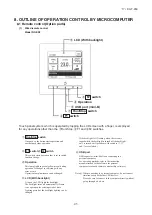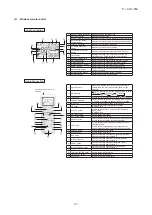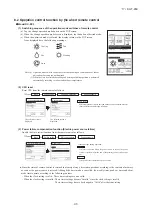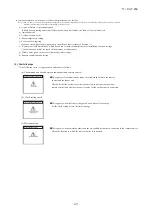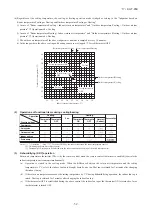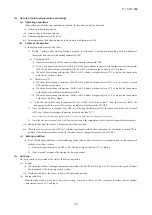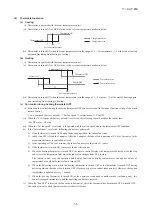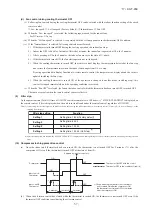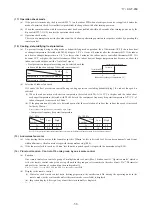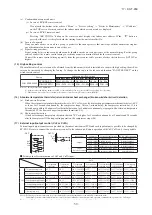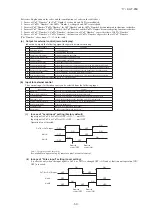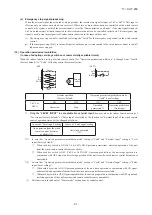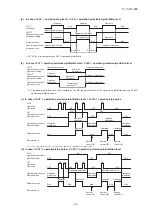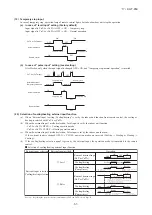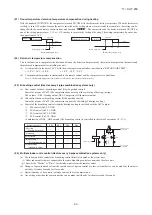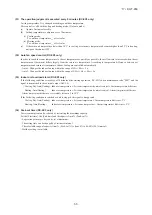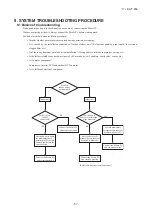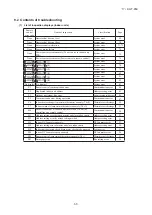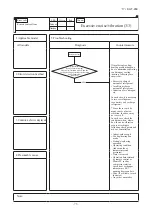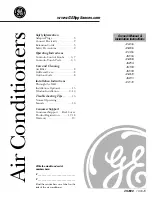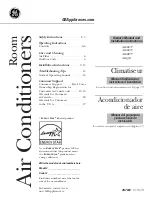
–
58
–
'17 • KX-T-259
-
125
-
'16 • PAC-T-251
(c) Operation check mode
There is no communication with the outdoor unit but it allows performing operation in respective modes by operating the
remote control.
(d) Drain pump test run mode
As the drain pump test run is established, the drain pump only operates and during the operation protective functions by
the microcomputer of indoor unit become ineffective.
(14) Cooling, dehumidifying frost protection
(a) To prevent frosting during cooling mode or dehumidifying mode operation, the of compressor speed is reduced if
the indoor heat exchanger temperature (detected with Thi-R) drops to 1.0 °C or lower at 4 minutes after the start of
compressor operation. If the indoor unit heat exchanger temperature is 1.0 °C or lower after 1 minutes, the compressor
speed is reduced further. If it becomes 2.5 °C or higher, the control terminates. When the indoor heat exchanger
temperature has become as show below after reducing the compressor speed, it is switched to the fan operation. For the
selection of indoor fan speed, refer to item 2).
10
1.0
Indoor heat exchanger temperature (°C)
Fan operation
Cooling operation
(b) Selection of indoor fan speed
If it enters the frost prevention control during cooling operation (excluding dehumidifying), the indoor fan speed is
switched.
(i) When the indoor return air detection temperature (detected with Thi-A) is 23°C or higher and the indoor heat
exchanger temperature (detected with Thi-R) detects the compressor frequency drop start temperature A°C+1°C, of
indoor fan speed is increased by 20min
-1
.
(ii) If the phenomenon of (i) above is detected again after the acceleration of indoor fan, indoor fan speed is increased
further by 20min
-1
.
Note (1) Indoor fan speed can be increased by up to 2 taps.
• Compressor frequency drop start temperature
Symbol
Item
A
Temperature - Low (Factory default)
1.0
Temperature - High
2.5
Note (1) Frost prevention temperature setting can be selected with the indoor unit function setting of the wired remote control.
(15) Heating overload protection
(a) If the indoor heat exchanger temperature (detected with Thi-R) at 63°C or higher is detected for 2 seconds continuously,
the compressor stops. When the compressor is restarted after a 3-minute delay, if a temperature at 63°C or higher is
detected for 2 seconds continuously within 60 minutes after initial detection and if this is detected 5 times consecutively,
the compressor stops with the anomalous stop (E8). Anomalous stop occurs also when the indoor heat exchanger
temperature at 63°C or higher is detected for 6 minutes continuously.
56
63
Indoor heat exchanger temperature (°C)
Compressor ON
Compressor OFF
(b) Indoor fan speed selection
If, after second detection of heating overload protection up to fourth, the indoor fan is set at Me and Lo taps when the
compressor is turned ON, the indoor fan speed is increased by 1 tap.
(13) Anomalous fan motor
(a)
After starting the fan motor, if the fan motor speed is 200min
-1
or less is detected for 30 seconds continuously and 4 times
within 60 minutes, then fan motor stops with the anomalous stop (E16).
(b) If the fan motor fails to reach at -50
min
-1
less than the required speed, it stops with the anomalous stop (E20).
(11) Operation check mode
(a) If the power is turned on by the dip switch (SW7-1) on the indoor PCB when electric power source is supplied, it enters the
mode of operation check. It is ineffective (prohibited) to change the switch after turning power on.
(b) When the communication with the remote control has been established within 60 seconds after turning power on by the
dip switch (SW7-1) ON, it enters the operation check mode.
(c) Operation check mode
There is no communication with the outdoor unit but it allows performing operation in respective modes by operating the
remote control.
(12) Cooling, dehumidifying frost protection
(a) To prevent frosting during cooling mode or dehumidifying mode operation, the of thermostat-OFF if the indoor heat
exchanger temperature (detected with ThI-R) drops to 1.0 °C or lower at 4 minutes after the thermostat-ON. If the indoor
unit heat exchanger temperature is 1.0 °C or lower after 5 minutes, the indoor unit is controlled thermostat-OFF. If it
becomes 10°C or higher, the control terminates. When the indoor heat exchanger temperature has become as show, the
indoor unit send outdoor unit the “Anti-frost” signal.
10
A
Indoor heat exchanger temperature (°C)
Thermostat-OFF
5 minutes
Thermostat-ON capable
SRC40~60
FDC100~140
Model
Symbol
A
4
4
1
1
1.0
1.0
2.5
2.5
B
C
D
• Frost prevention temperature setting can be selected with the
indoor unit function setting of the wired remote control.
Symbol
Item
A
Temperature - Low (Factory default)
1.0
Temperature - High
2.5
-
126
-
'16 • PAC-T-251
(14) Plural unit control – Control of 16 units group by one remote control
(a
) Function
One remote control can control a group of multiple number of unit (Max. 16 indoor units). “Operation mode” which is
set by the remote control can operate or stop all units in the group one after another in the order of unit. No.
(1)
. Thermostat
and protective function of each unit function independently.
Note (1) Unit No. is set by SW1, SW2 and SW5-2 on the indoor control PCB. Unit No. setting by SW2 is necessary for the indoor unit only. In cases of the twin, triple and
double twin specification, it is necessary set for the master and the slave units. This can be selected by SW5. (All are set for the master unit at the
shipping from factory.)
(2) Unit No. may be set at random unless duplicated, it should be better to set orderly like 0, 1, 2…, F to avoid mistake.
(b) Display to the remote control
(i) Central or each remote control basis, heating preparation: the smallest unit No. among the operating units in the
remote mode (or the center mode unless the remote mode is available) is displayed.
(ii) Inspection display, filter sign: Any of unit that starts initially is displayed.
(c) Confirmation of connected units
(i) In case of RC-EX3 remote control
If you touch the buttons in the order of “Menu”
→
“Service setting”
→
“Service & Maintenance”
→
“IU address”
on the TOP screen of remote control, the indoor units which are connected are displayed.
(ii) In case of RC-E5 remote control
Pressing “AIR CON No.” button on the remote control displays the indoor unit address. If “
▲
” “
▼
” button is
pressed at the next, it is displayed orderly starting from the unit of smallest No.
(d) In case of anomaly
If any anomaly occurs on a unit in a group (a protective function operates), that unit stops with the anomalous stop but
any other normal units continue to run as they are.
(e)
Signal wiring procedure
Signal wiring between indoor and outdoor units should be made on each unit same as the normal wiring. For the group
control, connect the remote control wiring to each indoor unit via terminal block for the remote control.
Connect the remote control wiring separately from the power source cable or wires of other electric devices (AC220V or
higher).
(18) High ceiling control
When sufficient air flow rate cannot be obtained from the indoor unit which is installed at a room with high ceiling, the air flow
rate can be increased by changing the fan tap. To change the fan tap, use the indoor unit function “FAN SPEED SET” on the
wired remote control.
-
-
-
-
-
-
-
STANDARD
HIGH SPEED1
[Setting 1]
[Setting 2]
HIGH SPEED2
FAN SPEED SET
Hi - ULo
Hi - Lo
Hi - Me
Hi - Me - ULo
Hi - Me - Lo
PHi2 - Hi - Me - ULo
PHi1 - Hi
PHi1 - Me
PHi1 - Hi - Me
PHi2 - PHi1 - Hi - Me
PHi2 - Hi - Me - Lo
Indoor unit airflow setting
Fan tap
Hi - Me
Notes (1) Factory default is STANDARD.
(2) At the hot-start and heating thermostat OFF, or other, the indoor fan is operated at the low speed tap of each setting.
(3) This function is not able to be set with wireless remote controls or simple remote control (RCH-E3)
(4) Values in [ ] are for the RC - EX3 models.
SW2: For setting of 0 – 9, A – F
SW5: For setting of master and slave units
(See table shown at right.)
Remote control
Indoor unit
Outdoor unit
Signal wiring
between outdoor unit
and indoor units
(Master unit)
(Slave unit a)
(Slave unit b)
Remote control wiring
R
0
1
2
3
F
4
4
4
(Slave unit c)
4
Refrigerant piping
Master unit
OFF
OFF
OFF
ON
SW5-1
SW5-2
ON
OFF
ON
ON
Slave unit a
Slave unit b
Slave unit c
Switch
Unit
SW5 setting
P2.indb 126
2/20/2017 1:08:37 PM
C
M
Y
CM
MY
CY
CMY
K
P58-1.pdf 2017/03/21 12:38:12
-
125
-
'16 • PAC-T-251
(c) Operation check mode
There is no communication with the outdoor unit but it allows performing operation in respective modes by operating the
remote control.
(d) Drain pump test run mode
As the drain pump test run is established, the drain pump only operates and during the operation protective functions by
the microcomputer of indoor unit become ineffective.
(14) Cooling, dehumidifying frost protection
(a) To prevent frosting during cooling mode or dehumidifying mode operation, the of compressor speed is reduced if the
indoor heat exchanger temperature (detected with Thi-R) drops to A °C or lower at 4 minutes after the start of compressor
operation. If the indoor unit heat exchanger temperature is A °C or lower after 1 minutes, the compressor speed is reduced
further. If it becomes B °C or higher, the control terminates. When the indoor heat exchanger temperature has become
as shown below after reducing the compressor speed, it is switched to the fan operation. For the selection of indoor fan
speed, refer to item (b).
When the indoor return air detected relative humidity (detected with HS) is lower than 50%, the temperature A and B is
changed as shown in the table.
10
A
Indoor heat exchanger temperature (°C)
Fan operation
Cooling operation
(b) Selection of indoor fan speed
If it enters the frost prevention control during cooling operation (excluding dehumidifying), the indoor fan speed is
switched.
(i) When the indoor return air detection temperature (detected with Thi-A) is 23°C or higher and the indoor heat
exchanger temperature (detected with Thi-R) detects the compressor frequency drop start temperature A°C+1°C, of
indoor fan speed is increased by 20min
-1
.
(ii) If the phenomenon of (i) above is detected again after the acceleration of indoor fan, indoor fan speed is increased
further by 20min
-1
.
Note (1) Indoor fan speed can be increased by up to 2 taps.
• Compressor frequency drop start temperature
Hs
>
50%
Hs
≦
50%
Item
Symbol
Low
High
Item
Symbol
Low
High
A
1.0
2.5
A
-0.5
1.0
B
2.5
4.0
B
1.0
2.5
Note (1) Frost prevention temperature setting can be selected with the indoor unit function setting of the wired remote control.
(15) Heating overload protection
(a) If the indoor heat exchanger temperature (detected with Thi-R) at 63°C or higher is detected for 2 seconds continuously,
the compressor stops. When the compressor is restarted after a 3-minute delay, if a temperature at 63°C or higher is
detected for 2 seconds continuously within 60 minutes after initial detection and if this is detected 5 times consecutively,
the compressor stops with the anomalous stop (E8). Anomalous stop occurs also when the indoor heat exchanger
temperature at 63°C or higher is detected for 6 minutes continuously.
56
63
Indoor heat exchanger temperature (°C)
Compressor ON
Compressor OFF
(b) Indoor fan speed selection
If, after second detection of heating overload protection up to fourth, the indoor fan is set at Me and Lo taps when the
compressor is turned ON, the indoor fan speed is increased by 1 tap.
(16) Anomalous fan motor
(a)
After starting the fan motor, if the fan motor speed is 200min
-1
or less is detected for 30 seconds continuously and 4 times
within 60 minutes, then fan motor stops with the anomalous stop (E16).
(b) If the fan motor fails to reach at -50
min
-1
less than the required speed, it stops with the anomalous stop (E20).
P2.indb 125
2/20/2017 1:08:37 PM
-
126
-
'16 • PAC-T-251
(14) Plural unit control – Control of 16 units group by one remote control
(a
) Function
One remote control can control a group of multiple number of unit (Max. 16 indoor units). “Operation mode” which is
set by the remote control can operate or stop all units in the group one after another in the order of unit. No.
(1)
. Thermostat
and protective function of each unit function independently.
Note (1) Unit No. is set by SW1, SW2 and SW5-2 on the indoor control PCB. Unit No. setting by SW2 is necessary for the indoor unit only. In cases of the twin, triple and
double twin specification, it is necessary set for the master and the slave units. This can be selected by SW5. (All are set for the master unit at the
shipping from factory.)
(2) Unit No. may be set at random unless duplicated, it should be better to set orderly like 0, 1, 2…, F to avoid mistake.
(b) Display to the remote control
(i) Central or each remote control basis, heating preparation: the smallest unit No. among the operating units in the
remote mode (or the center mode unless the remote mode is available) is displayed.
(ii) Inspection display, filter sign: Any of unit that starts initially is displayed.
(c) Confirmation of connected units
(i) In case of RC-EX3 remote control
If you touch the buttons in the order of “Menu”
→
“Service setting”
→
“Service & Maintenance”
→
“IU address”
on the TOP screen of remote control, the indoor units which are connected are displayed.
(ii) In case of RC-E5 remote control
Pressing “AIR CON No.” button on the remote control displays the indoor unit address. If “
▲
” “
▼
” button is
pressed at the next, it is displayed orderly starting from the unit of smallest No.
(d) In case of anomaly
If any anomaly occurs on a unit in a group (a protective function operates), that unit stops with the anomalous stop but
any other normal units continue to run as they are.
(e)
Signal wiring procedure
Signal wiring between indoor and outdoor units should be made on each unit same as the normal wiring. For the group
control, connect the remote control wiring to each indoor unit via terminal block for the remote control.
Connect the remote control wiring separately from the power source cable or wires of other electric devices (AC220V or
higher).
(18) High ceiling control
When sufficient air flow rate cannot be obtained from the indoor unit which is installed at a room with high ceiling, the air flow
rate can be increased by changing the fan tap. To change the fan tap, use the indoor unit function “FAN SPEED SET” on the
wired remote control.
-
-
-
-
-
-
-
STANDARD
HIGH SPEED1
[Setting 1]
[Setting 2]
HIGH SPEED2
FAN SPEED SET
Hi - ULo
Hi - Lo
Hi - Me
Hi - Me - ULo
Hi - Me - Lo
PHi2 - Hi - Me - ULo
PHi1 - Hi
PHi1 - Me
PHi1 - Hi - Me
PHi2 - PHi1 - Hi - Me
PHi2 - Hi - Me - Lo
Indoor unit airflow setting
Fan tap
Hi - Me
Notes (1) Factory default is STANDARD.
(2) At the hot-start and heating thermostat OFF, or other, the indoor fan is operated at the low speed tap of each setting.
(3) This function is not able to be set with wireless remote controls or simple remote control (RCH-E3)
(4) Values in [ ] are for the RC - EX3 models.
SW2: For setting of 0 – 9, A – F
SW5: For setting of master and slave units
(See table shown at right.)
Remote control
Indoor unit
Outdoor unit
Signal wiring
between outdoor unit
and indoor units
(Master unit)
(Slave unit a)
(Slave unit b)
Remote control wiring
R
0
1
2
3
F
4
4
4
(Slave unit c)
4
Refrigerant piping
Master unit
OFF
OFF
OFF
ON
SW5-1
SW5-2
ON
OFF
ON
ON
Slave unit a
Slave unit b
Slave unit c
Switch
Unit
SW5 setting
P2.indb 126
2/20/2017 1:08:37 PM
C
M
Y
CM
MY
CY
CMY
K
P58-1.pdf 2017/03/21 12:38:12


